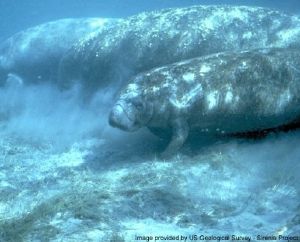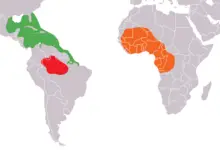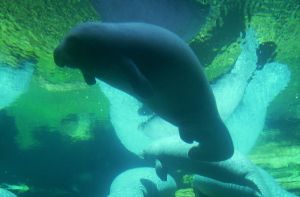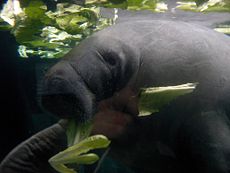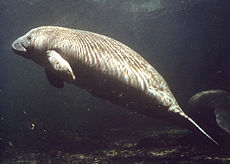Manatee
| Sirenia
| ||||||||||||
|---|---|---|---|---|---|---|---|---|---|---|---|---|
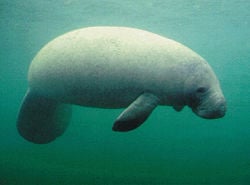 Antillean Manatee
| ||||||||||||
| Scientific classification | ||||||||||||
| ||||||||||||
|
Trichechus inunguis |
Manatee is the common name for large, herbivorous, fully aquatic marine mammals comprising the family Trichechidae, characterized by a nearly hairless body with paddle-like front flippers, small eyes, no external ear, and absence of hind limbs (although there are vestigial pelvic bones). There is one genus recognized in the family, Trichecus, which includes three extant species. Manatees are found in both freshwater and marine environments in parts of the Americas and Africa.
Manatees, which sometimes are known as sea cows, are part of the order Sirenia along with dugongs. Sirenians are one of four groups of marine mammals, the others being cetaceans (whales, dolphins, and porpoises), sea otters, and pinnipeds (walruses, earless seals, and eared seals). The sirenians and cetaceans are completely aquatic, while pinnipeds spend considerable time on land, including giving birth and raising their young, and sea otters can mate and raise their young entirely at sea. Sirenia is thought to have evolved from four-legged land mammals over 60 million years ago, with the closest living relatives being the Proboscidea (elephants) and Hyracoidea (hyraxes) (Domning 1994).
Manatees are important to the food chains in their aquatic habitats, consuming a wide variety of different aquatic plants and algae and, although the adults have few predators, manatees are consumed by sharks, crocodiles, and orcas. They have long been tied to culture. They traditionally have been hunted for their meat and to make various products (war shields, canoes, shoes) and their bones were ground to treat asthma and earache. In West African folklore, the manatee was considered sacred and thought to have been once human; killing one was taboo and required penance (Cooper 1992). Today, manatees are now considered endangered and protected. One of their main sources of mortality today is collisions with boats and propellers.
Description
The body of the manatee is largely hairless, somewhat oval in cross section, and with short, flexible and paddlelike forelimbs, a broad, horizontally flattened tail, and no hind limbs, although the pelvic musculature has the presence of vestigial pelvic bones. With the exception of the Amazonian manatee, Trichechus inunguis, there are three or four nails on the end of the forelimbs; Amazonian manatees lack the nails in the forelimbs. There is a small, hard to see external ear opening, but no pinna (external ear). Testes are internal, and mammary glands are paired, with a single nipple in each axilla (Odell 2004).
The upper lips of manatees are split and described as prehensile (Odell 2004). In many ways, the upper lip acts like a shortened trunk, somewhat similar to an elephant's. They use the lip to gather food and eat, as well as using it for social interactions and communications. Their small, widely spaced eyes have eyelids that close in a circular manner. Manatees are also believed to have the ability to see in color. The main visual difference between manatees and dugongs are the tails. A manatee tail is paddle-shaped, while a dugong tail is forked, similar in shape to a whale's.
Like horses, manatees have a simple stomach, but a large cecum, in which they can digest tough plant matter. In general, their intestines are unusually long for animals of their size.
Adult manatees have no incisor or canine teeth, just a set of cheek teeth, which are not clearly differentiated into molars and premolars. Uniquely among mammals, these teeth are continuously replaced throughout life, with new teeth entering at the back of the jaw and replacing old and worn teeth at the front, with the older teeth falling out from further forward in the mouth. Thought to be their close cousins, the elephants also have teeth that get replaced, but they have a limited set of these replacement teeth. At any given time, a manatee typically has no more than six teeth (Best 1984).
Generally, manatees have a mean mass of 400 to 550 kilograms (900-1200 pounds]]) and mean length of 2.8 to 3.0 meters (9-10 feet), with maximums of 3.6 meters and 1,775 kg seen (the females tend to be larger and heavier). When born, baby manatees have an average mass of 30 kilograms. The body color generally is gray to brownish, but may have algae and other epiphytes that result in another appearance (Odell 2004).
Florida manatees (T. m. latirostris) have been known to live up to 60 years. They have few natural predators, but are preyed upon by sharks, crocodiles, orcas, and alligators.
Much of the knowledge about extant manatees is based upon research done in Florida and cannot necessarily be attributed to all types of manatees. The name manatí comes from the Taíno, a pre-Columbian people of the Caribbean, meaning "breast" (Winger 2000).
Distribution and habitat
Manatees inhabit the shallow, marshy coastal areas and rivers of the Caribbean Sea and the Gulf of Mexico (T. manatus, West Indian manatee), the Amazon Basin (T. inunguis, Amazonian manatee), and West Africa (T. senegalensis, West African manatee). There has been a proposal for recognition of a fourth species, the Ddwarf manatee (T. bernhardi), for a population found in the Brazilian Amazon (van Roosmalen 2008), although some strongly consider it to just be an immature Amazonian manatee, as backed up by DNA evidence (Hammer 2008). Florida manatees (T. m. latirostris) have been known to live up to 60 years, and they can move freely between different salinity extremes; however, Amazonian manatees (T. inunguis) never venture out into salt water. Studies in Florida suggest that Florida manatees must have some access to fresh water for proper osmoregulation.
Florida is usually the northernmost range of the West Indian manatee as their low metabolic rate makes cold weather endurance difficult. They may on occasion stray up the mid-Atlantic coast in summer. Half a manatee's day is spent sleeping in the water, surfacing for air regularly at intervals no greater than 20 minutes.
Manatees typically inhabit warm, shallow, coastal estuarine waters and cannot survive below 15°C (288 K; 60°F). Their natural source for warm waters during the winter is warm-spring fed rivers. The West Indian manatee migrates into Florida rivers such as the Crystal River, the Homosassa River, and the Chassahowitzka River. The head springs of these rivers maintain a water temperature of 22°C (299 K; 72°F) year round. During the winter months, November to March, approximately 400 West Indian manatees (according to the National Wildlife Refuge) congregate in the rivers in Citrus County, Florida.
Manatees have been spotted as far north as Cape Cod, and as recently as the late summer of 2006, one made it up to New York City and Rhode Island's Narragansett Bay, as cited by The Boston Globe. According to Memphis, Tennessee's The Commercial Appeal newspaper, one manatee was spotted in the Wolf River harbor near the Mississippi River in downtown Memphis, Tennessee, on October 23, 2006, though it was later found dead ten miles downriver in McKellar Lake (Charlier 2006).
Manatees often congregate near power plants, which warm the waters. Some have become reliant on this source of artificial heat and have ceased migrating to warmer waters. Some power plants have recently been closing and the U.S. Fish and Wildlife Service is trying to find a new way to heat the water for these manatees. The main water treatment plant in Guyana has four manatees that keep storage canals clear of weeds.
Manatees spend most of their time grazing in shallow waters and at depths of 1 to 2 meters (3-7 feet).
Behavior, diet, and reproduction
On average, most manatees swim at about 5 to 8 kilometers per hour (1.4 to 2.2 meters/second or 3 to 5 miles per hour). However, they have been known to swim up to 30 kilometers/hour (8 meters/second; 20 miles per hour) in short bursts.
Manatees are herbivores and eat over 60 different plant species such as mangrove leaves, turtle grass, and types of algae, using their divided upper lip. An adult manatee will commonly eat up to nine percent of its body weight (approx 50 kilograms) per day. Manatees have been known to eat small amounts of fish from nets (Powell 1978).
Manatees emit a wide range of sounds used in communication, especially between cows and their calves, yet also between adults to maintain contact and during sexual and play behaviors. They may use taste and smell, in addition to sight, sound, and touch, to communicate. Manatees are capable of understanding discrimination tasks, and show signs of complex associated learning and advanced long term memory (Gerstein 1994). They demonstrate complex discrimination and task-learning similar to dolphins and pinnipeds in acoustic and visual studies (Dierauf and Gulland 2001).
Manatees typically breed only once every other year, since gestation lasts about 12 months, and it takes a further 12 to 18 months to wean the calf. Only a single calf is born at a time and aside from mothers with their young or males following a receptive female, manatees are generally solitary creatures (Best 1984).
Species and population size
The population of manatees in Florida (T. manatus) is thought to be between 1,000 and 3,000, yet population estimates are very difficult. The number of manatee deaths in Florida caused by humans has been increasing through the years, and now typically accounts for 20 percent-40 percent of recorded manatee deaths (FWRI 2008). There were near 300 registered and confirmed manatees in Florida killed by human activity in 2006; the majority of these, that happened to be discovered by Florida Fish and Wildlife, have been caused by boat strikes.
Accurate population estimates of the Florida manatee are notoriously difficult and have been called scientifically weak. With widely varying counts from year to year, some areas show possible increases yet others decreases, with very little strong evidence of increases except in 2 areas. However, population viability analysis studies carried out in 1997, found that decreasing adult survival and eventual extinction is a probable future outcome for the Florida manatees, unless they are aggressively protected (Marmontel et al. 1997). Manatee counts are highly variable without an accurate way to estimate numbers. In Florida in 1996, a winter survey found 2,639 manatees; in 1997, a January survey found 2,229; and a February survey found 1,706 (Dierauf and Gulland 2001). Fossil remains of manatee ancestors show they have inhabited Florida for about 45 million years.
The Amazonian manatee (T. inunguis) is a species of manatee that lives in the freshwater habitats of the Amazon River and its tributaries. Their color is brownish gray and they have thick, wrinkled skin, often with coarse hair, or "whiskers." Its main predator is also man. The Brazilian government has outlawed the hunting of the manatee since 1973 in an effort to preserve the species. Deaths by boat strikes, however, are still common.
The African manatee (T. senegalensis) is the least studied of the three species of manatees. Photos of African Manatees are very rare; although very little is known about this species, scientists think they are similar to the West Indian manatees. They are found in coastal marine and estuarine habitats, and in fresh water river systems along the west coast of Africa from the Senegal River south to the Kwanza River in Angola, including areas in Gambia, Liberia, Guinea-Bissau, Guinea, Sierra Leone, Côte d'Ivoire, Ghana, Mali, Nigeria, Cameroon, Gabon, Republic of the Congo, and Democratic Republic of the Congo. Although crocodiles and sharks occasionally kill manatees in Africa, their only significant threats are from humankind due to poaching, habitat loss, and other environmental impacts. They live as high upriver on the Niger as Gao, Mali. Although rare, they occasionally get stranded as the river dries up at the end of rainy season and are cooked for a meal. The name in Sonrai, the local language, is "ayyu."
Vulnerability and conservation
Although manatees have few natural predators, all three species of manatee are listed by the World Conservation Union as vulnerable to extinction. On June 8, 2006, the Florida Fish and Wildlife Conservation Commission voted to reclassify the manatee on Florida's list, to a "threatened" status in that state (FWC 2008). While none of the state laws protecting manatees have changed, many wildlife conservationists are not pleased with the removal decision. Manatees remain classified as "endangered" at the federal level.
The current main threat to manatees in the United States is being struck with boats or slashed with propellers. Manatees are slow-moving, non-aggressive, and generally curious creatures. They enjoy warmer waters and are known to congregate in shallow waters, and frequently migrate through brackish water estuaries to freshwater springs. Their slow-moving, curious nature, coupled with dense coastal development, has led to a number of violent collisions with fast moving recreational motor boats and their propellers, leading frequently to maiming, disfigurement, and even death.
Sometimes manatees can live through collisions with boats, but have severe injuries. On some manatees off the Florida coast, a large portion of manatees exhibit scars on their backs and they are now even classed by humans from their scar patterns. There are findings of upwards of 50 scars and disfigurements from boat strikes on a single manatee (Dierauf and Gulland 2001; Kennedy 2006). In other cases, the wounds are fatal, whether as a result of internal injuries or because the cuts often lead to infections (Dierauf and Gulland 2001; Kennedy 2006).
According to marine mammal veterinarians, "The severity of mutilations for some of these individuals can be astounding—including long term survivors with completely severed tails, major tail mutilations, and multiple disfiguring dorsal lacerations. These injuries not only cause gruesome wounds, but may also impact population processes by reducing calf production (and survival) in wounded females— observations also speak to the likely pain and suffering endured" (Dierauf and Gulland 2001). In an example, Dierauf and Gulland (2001) cited one case study of a small calf "with a severe dorsal mutilation trailing a decomposing piece of dermis and muscle as it continued to accompany and nurse from its mother… by age 2 its dorsum was grossly deformed and included a large protruding rib fragment visible" (Dierauf and Gulland 2001). These veterinarians go on to state that "the overwhelming documentation of gruesome wounding of manatees leaves no room for denial. Minimization of this injury is explicit in the Recovery Plan, several state statutes, and federal laws, and implicit in our society's ethical and moral standards" (Dierauf and Gulland 2001).

There are other anthropogenic risks for manatees. Manatees occasionally ingest fishing gear (hooks, metal weights, and so on) while feeding. These foreign materials generally do not seem to harm manatees, with the notable exception of monofilament line or string. This can clog the animal's digestive system and slowly kill the animal.
Manatees can also be crushed in water control structures (navigation locks, floodgates, among others), drown in pipes and culverts, and are occasionally killed from entanglement in fishing gear, primarily crab pot float lines. Manatees are also vulnerable to red tides—blooms of algae, which leach oxygen from the water.
Hunting traditionally has posed a risk. Manatees were commonly hunted for their meat by natives of the Caribbean, although this is much less common today (Nunez 2008). When Christopher Columbus arrived in the region, manatee hunting was an established trade. Native Americans hunted manatees to make war shields, canoes, and shoes, though the manatee was predominantly hunted for its abundant meat. The primary method of hunting the manatee was somewhat crude, as the hunter would use dugout canoes to approach targeted manatees. The indigenous hunter would then use various methods of baiting in order to attract a manatee close enough to hit the animal near the head with an oar-like pole, temporarily stunning the manatee. Many times the creature would flip over, leaving it vulnerable to further attacks.
Manatees were also hunted for their valuable bones, which were used to make "special potions." Up until the 1800s, museums paid as much as $100 for manatee bones or hides. Though hunting manatees was banned in 1893, poaching continues today.
In the United States, it is illegal under federal and Florida law to cause the manatees injury or harm (Dierauf and Gulland 2001). While humans are allowed to swim with manatees in one area of Florida (STMC 2008), there have been numerous charges of people harassing and disturbing the manatees in various ways, in addition to the concern about repeated motorboat strikes.
ReferencesISBN links support NWE through referral fees
- Best, R. 1984. Manatee. Pages 292-298 in D. Macdonald, The Encyclopedia of Mammals. New York: Facts on File. ISBN 0871968711.
- Charlier, T. 2006. Manatee's corpse recovered; goes to zoo for analysis. The Commercial Appeal December 13, 2006.
- Cooper, J. C. 1992. Symbolic and Mythological Animals. London: Aquarian Press. ISBN 1855381184.
- Dierauf, L. A., and F. M. D. Gulland. 2001. CRC Handbook of Marine Mammal Medicine. Boca Raton, FL: CRC Press. ISBN 0849308399.
- Domning, D. P., 1994. Paleontology and evolution of sirenians: Status of knowledge and research needs. Proceeding of the 1st International Manatee and Dugong Research Conference, Gainesville, Florida.
- Fish and Wildlife Research Institute (FWRI). 2008. Yearly mortality summaries: 1974 to 2006 yearly summaries of manatee deaths for the state of Florida. Florida Fish and Wildlife Conservation Commission. Retrieved October 1, 2008.
- Fish and Wildlife Conservation Commission (FWC). 2008. FWC Manatee Program. Fish and Wildlife Conservation Commission. Retrieved October 1, 2008.
- Gerstein, E. R., 1994. The manatee mind: Discrimination training for sensory perception testing of West Indian manatees (Trichechus manatus). Mar. Mammals 1: 10-21.
- Hammer, J. 2008. Trials of a primatologist. How did a renowned scientist who has done groundbreaking research in Brazil run afoul of authorities there? Smithsonian February 2008. Retrieved October 1, 2008.
- Kennedy, K. 2006. Florida boaters killing endangered manatees. CDNN. Retrieved September 30, 2008.
- Marmontel, M., S. R. Humphrey, and T. J. O'Shea. 1997. Population variability analysis of the Florida manatee, 1976-1992. Conserv. Biol. 11: 467-481. Retrieved October 1, 2008.
- Nuñez, A. 2008. Hunting for manatees. Ambergris Caye. Retrieved October 1, 2008.
- Powell, J. 1978. Evidence for carnivory in manatees (Trichechus manatus). Journal of Mammalogy 59(2): 442.
- Save the Manatee Club. 2008. Help end manatee harassement in Citrus County, Florida! Savethemanatee.org. Retrieved October 1, 2008.
- Shoshani, J. 2005. Manatee. Page 93 in D. E. Wilson, and D. M. Reeder (eds.), Mammal Species of the World, 3rd edition. Johns Hopkins University Press. ISBN 0801882214.
- van Roosmalen, M. G. H., P. van Hoft, and H. H. van Iongh. 2008. New species: Dwarf manatee. Amazon Association for the Preservation of Nature. Retrieved September 30, 2008.
- Winger, J. 2000. Manatees and duogong. ZooGoer 34(6). Smithsonian National Zoological Park. Retrieved October 1, 2008.
Credits
New World Encyclopedia writers and editors rewrote and completed the Wikipedia article in accordance with New World Encyclopedia standards. This article abides by terms of the Creative Commons CC-by-sa 3.0 License (CC-by-sa), which may be used and disseminated with proper attribution. Credit is due under the terms of this license that can reference both the New World Encyclopedia contributors and the selfless volunteer contributors of the Wikimedia Foundation. To cite this article click here for a list of acceptable citing formats.The history of earlier contributions by wikipedians is accessible to researchers here:
The history of this article since it was imported to New World Encyclopedia:
Note: Some restrictions may apply to use of individual images which are separately licensed.
